Gravitational Waveforms

The gravitational wavetrain from a compact binary system may be separated into three qualitatively different phases: the inspiral, merger, and ringdown. During the inspiral phase, which takes up most of the binary's lifetime, gravity wave emission gradually reduces the binary separation. The merger phase of the gravitational wavetrain is characterized by tidal disruption of the neutron star. Finally, ringdown radiation is emitted as the distorted black hole settles down to Kerr-like equilibrium (Note: Only in the case of a vacuum spacetime does the spinning BH obey the exact Kerr solution. The BHs formed here are surrounded by gaseous disks with small, but nonnegligible, rest mass). Both polarization modes (h+ and hx) are shown.
In this case, there is no magnetic field inserted into the neutron star. Shown below are hx in both hemispheres and h+ in just the lower hemisphere. Waveforms are plotted in the region of r/M ≥ 40.
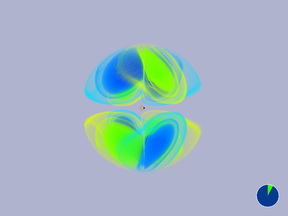 Fig. 2-1: hx at time t/M = 674 |
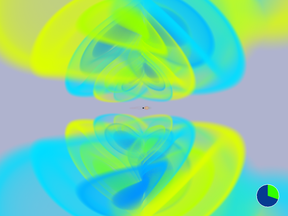 Fig. 2-2: hx at time t/M = 832 |
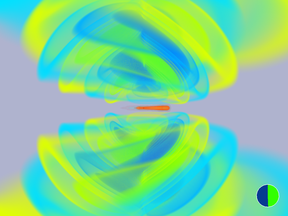 Fig. 2-3: hx at time t/M = 963 |
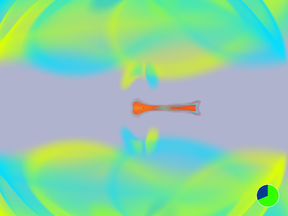 Fig. 2-4: hx at time t/M = 1094 |
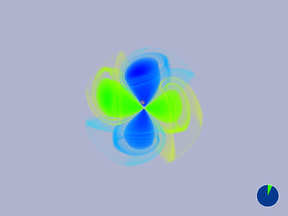 Fig. 2-5: h+ at time t/M = 674 |
 Fig. 2-6: h+ at time t/M = 832 |
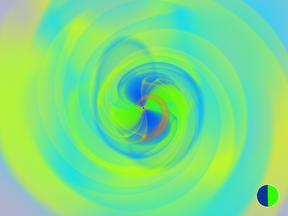 Fig. 2-7: h+ at time t/M = 963 |
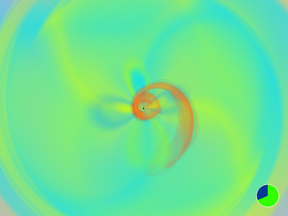 Fig. 2-8: h+ at time t/M = 1094 |
In this case, the magnetic field is inserted into the neutron star and is aligned with its orbital axis. Shown below are hx in both hemispheres, h+ in just the lower hemisphere, and h+ in both hemispheres. Waveforms are plotted in the region of r/M ≥ 40.
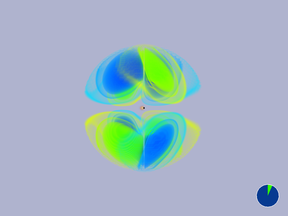 Fig. 3-1: hx at time t/M = 674 |
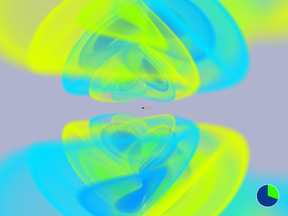 Fig. 3-2: hx at time t/M = 832 |
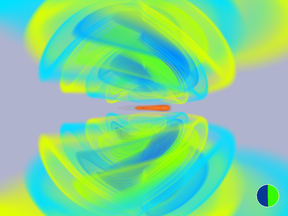 Fig. 3-3: hx at time t/M = 963 |
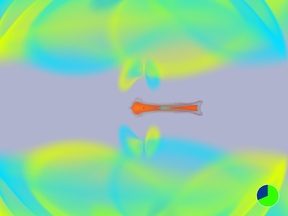 Fig. 3-4: hx at time t/M = 1094 |
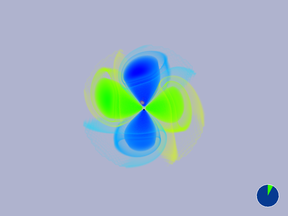 Fig. 3-5: h+ at time t/M = 674 |
 Fig. 3-6: h+ at time t/M = 832 |
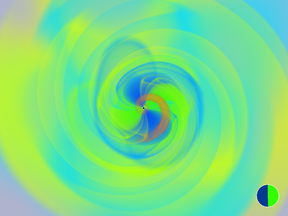 Fig. 3-7: h+ at time t/M = 963 |
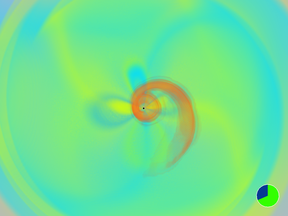 Fig. 3-8: h+ at time t/M = 1094 |
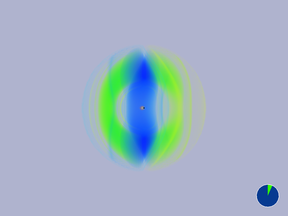 Fig. 3-9: h+ at time t/M = 674 |
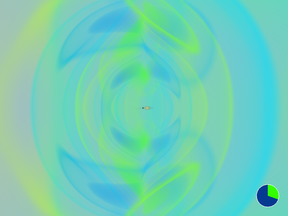 Fig. 3-10: h+ at time t/M = 832 |
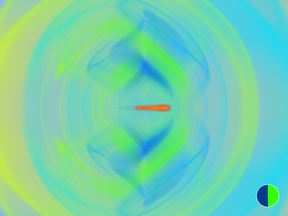 Fig. 3-11: h+ at time t/M = 963 |
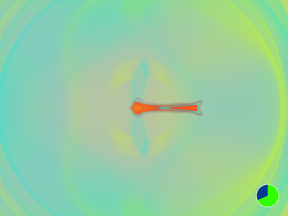 Fig. 3-12: h+ at time t/M = 1094 |
In this case, the magnetic field is inserted into the neutron star at a 45o to its orbital axis. Shown below are hx in both hemispheres and h+ in just the lower hemisphere. Waveforms are plotted in the region of r/M ≥ 40.
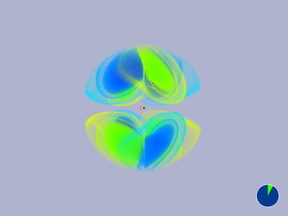 Fig. 4-1: hx at time t/M = 674 |
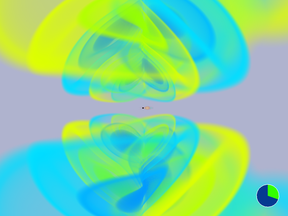 Fig. 4-2: hx at time t/M = 832 |
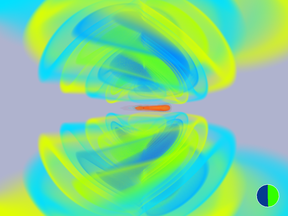 Fig. 4-3: hx at time t/M = 963 |
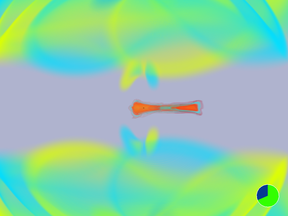 Fig. 4-4: hx at time t/M = 1094 |
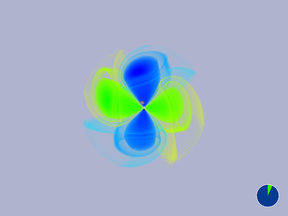 Fig. 4-5: h+ at time t/M = 674 |
 Fig. 4-6: h+ at time t/M = 832 |
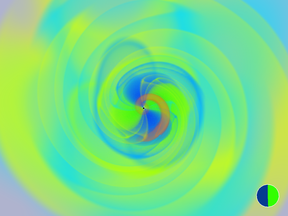 Fig. 4-7: h+ at time t/M = 963 |
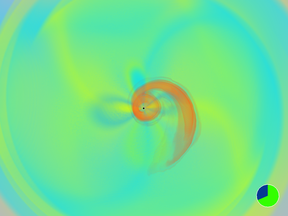 Fig. 4-8: h+ at time t/M = 1094 |
In this case, the magnetic field is inserted into the neutron star at a 45o to its orbital axis. Shown below are hx in both hemispheres and h+ in just the lower hemisphere. Waveforms are plotted in the region of r/M ≥ 40.
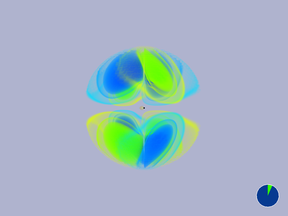 Fig. 5-1: hx at time t/M = 674 |
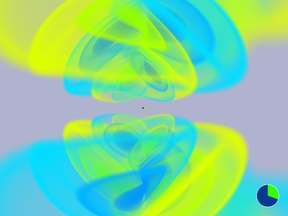 Fig. 5-2: hx at time t/M = 832 |
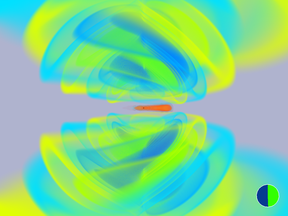 Fig. 5-3: hx at time t/M = 963 |
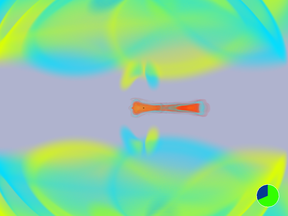 Fig. 5-4: hx at time t/M = 1094 |
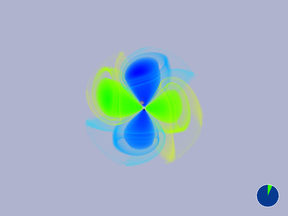 Fig. 5-5: h+ at time t/M = 674 |
 Fig. 5-6: h+ at time t/M = 832 |
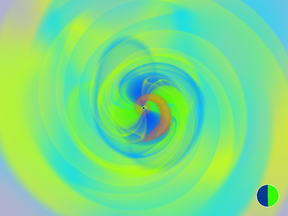 Fig. 5-7: h+ at time t/M = 963 |
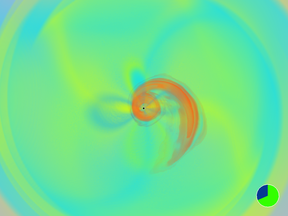 Fig. 5-8: h+ at time t/M = 1094 |
Shown below is the comparison between the h+ components of the four cases specified above. After four orbits, the unmagnetized interior of the unmagnetized neutron star is seeded with a magnetic field parallel (top right), tilted 45o (bottom left), and perpendicular (bottom right) to their orbital axis. The top left star is left unmagnetized.
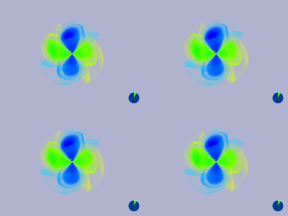 Fig. 6-1: h+ at time t/M = 674 |
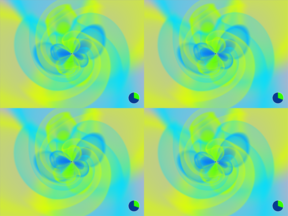 Fig. 6-2: h+ at time t/M = 832 |
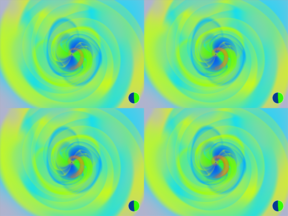 Fig. 6-3: h+ at time t/M = 963 |
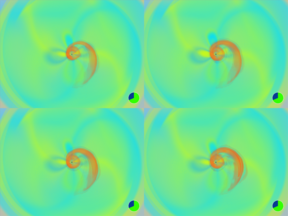 Fig. 6-4: h+ at time t/M = 1094 |
Given the weakness of the initial magnetic field, there are very few differences in the gravitational waveforms between the four cases.